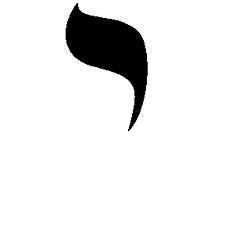Position in alphabet 10 Phonemic representation j, i, e | Numerical value 10 | |
 | ||
Yodh (also spelled Yud, Yod, Jod, or Jodh) is the tenth letter of the Semitic abjads, including Phoenician Yōd , Hebrew Yōd י, Aramaic Yodh , Syriac Yōḏ ܚ, and Arabic Yāʾ ي (in abjadi order, 28th in modern order). Its sound value is /j/ in all languages for which it is used; in many languages, it also serves as a long vowel, representing /iː/.
Contents
- Yodh
- Origins
- Arabic y
- Perso Arabic ye
- Returned y
- Hebrew Yud
- Pronunciation
- Variations
- Significance
- In religion
- References
The Phoenician letter gave rise to the Greek Iota (Ι), Latin I, J, Cyrillic І, Й, Coptic iauda (Ⲓ) and Gothic eis .
Yodh
Origins
Yodh is thought to have originated with a pictograph of a hand that ultimately derives from Proto-Semitic *yad-. It may be related to the Egyptian hieroglyphic of an arm:
Arabic yāʼ
The letter ي is named yāʼ (يَاء). It is written in several ways depending on its position in the word:
It is pronounced in four ways:
As a vowel, yāʾ can serve as the "seat" of the hamza: ئ
Yāʾ serves several functions in the Arabic language. Yāʾ as a prefix is the marker for a singular imperfective verb, as in يَكْتُب yaktub "he writes" from the root ك-ت-ب K-T-B ("write, writing"). Yāʾ with a shadda is particularly used to turn a noun into an adjective, called a nisbah (نِسْبَة). For instance, مِصْر Miṣr (Egypt) → مِصْرِيّ Miṣriyy (Egyptian). The transformation can be more abstract; for instance, مَوْضَوع mawḍūʿ (matter, object) → مَوْضُوعِيّ mawḍūʿiyy (objective). Still other uses of this function can be a bit further from the root: إِشْتِرَاك ishtirāk (cooperation) → إِشْتِرَاكِيّ ishtirākiyy (socialist). The common pronunciation of the final /-ijj/ is most often pronounced as [i] or [iː].
A form similar to but distinguished from yāʾ is the ʾalif maqṣūrah (أَلِف مَقْصُورَة) "broken alif", with the form ى. It indicates a final long /aː/.
In Egypt, Sudan and sometimes the Maghreb, the final form is always ى (without dots), both in handwriting and in print, representing both final /-iː/ and /-aː/. ى representing final /-aː/ (DIN 31635 transliteration: ā) is less likely to occur in Modern Standard Arabic. In this case, it is commonly known as, especially in Egypt, أَلِف لَيِّنَة ʾalif layyinah [ˈʔælef læjˈjenæ]. In Egypt, it is always short [-æ, -ɑ] if used in Egyptian Arabic and most commonly short in Modern Standard Arabic, as well.
Perso-Arabic ye
In the Persian alphabet, the letter is generally called ye following Persian-language custom. In its final form, the letter does not have dots (ی), much like the Arabic ʾalif maqṣūrah or, more to the point, much like the custom in Egypt, Sudan and sometimes Maghreb. On account of this difference, Perso-Arabic ye is located at a different Unicode code point than both of the standard Arabic letters.
In computers, the Persian version of the letter automatically appears with two dots initially and medially: (یـ ـیـ ـی). The Arabic version without dots ى is not used initially or medially, and it is not joinable initially or medially in all fonts. However, it is used in the Uyghur Arabic alphabet and the Arabic-based Kyrgyz alphabet: (ىـ ـىـ).
In Kashmiri, it uses a ring instead from ي of a dots below (ؠ ؠـ ـؠـ ـؠ).
Returned yāʾ
In different calligraphic styles like the Hijazi script, Kufic, and Nastaʿlīq script, a final yāʾ might have a particular shape with the descender turned to the right (ـے), called al-yāʾ al-mardūdah/al-rājiʿah ("returned, recurred yāʾ"), either with two dots or without them.
In Urdu this is called baṛī ye ("big ye"), but is an independent letter used for /ɛː, eː/ and differs from the basic ye (choṭī ye, "little ye"). For this reason the letter has its own code point in Unicode. Nevertheless, its initial and medial forms are not different from the other ye (practically baṛī ye is not used in these positions).
Hebrew Yud
Hebrew spelling: יוֹד ; colloquial יוּד
Pronunciation
In both Biblical and modern Hebrew, Yud represents a palatal approximant ([j]).
Variations
Yud is a mater lectionis, like Aleph, He, and Vav. At the end of words with a vowel or when marked with a sh'va nach, it represents the formation of a diphthong, such as /ei/, /ai/, or /oi/.
Significance
In gematria, Yud represents the number ten.
As a prefix, it designates the third person singular (or plural, with a Vav as a suffix) in the future tense.
As a suffix, it indicates first person singular possessive; av (father) becomes avi (my father).
"Yod" in the Hebrew language signifies iodine.
In religion
Two Yuds in a row designate the name of God Adonai and in pointed texts are written with the vowels of Adonai; this is done as well with the Tetragrammaton.
As Yud is the smallest letter, much kabbalistic and mystical significance is attached to it. According to the Gospel of Matthew, Jesus mentioned it during the Antithesis of the Law, when he says: "One jot or one tittle shall in no wise pass from the law, till all be fulfilled." Jot, or iota, refers to the letter Yud; it was often overlooked by scribes because of its size and position as a mater lectionis. In modern Hebrew, the phrase "tip of the Yud" refers to a small and insignificant thing, and someone who "worries about the tip of a Yud" is someone who is picky and meticulous about small details.
Much kabbalistic and mystical significance is also attached to it because of its gematria value as ten, which is an important number in Judaism, and its place in the name of God.
